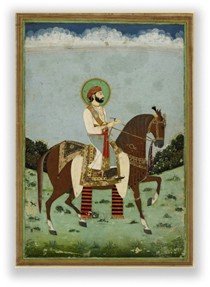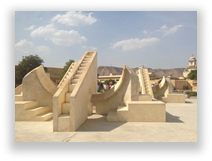Maharaja Jai Singh: The Monarch of Jaipur

Sawai Jai Singh II, the remarkable Monarch of Jaipur, was a mathematician, an astronomer, and a town planner par excellence. He set up the famous observatories known as Jantar Mantars and built the city of Jaipur.
Popularly known as Maharaja Sawai Jai Singh was the ruler of the Kingdom of Amber, who later founded the fortified city of Jaipur and made it his capital. He was born at Amber, the capital of the Kachwahas. He was the 29th Kachhwaha ruler. He became ruler of Amber at the age of 11 after the death of his father, Raja Bishan Singh on 31 December 1699. Maharaja Sawai Jai Singh (1688-1743) was the ruler of the Rajput State of Amber in India. A feudatory of the Mughals, he received the title of ‘Sawai’ (one and a quarter) from Emperor Aurangzeb, who declared him a quarter superior to his famous forebearer Mirza Raja Jai Singh (d. 1667) after he captured the Fort of Vishalgarh from the Marathas in 1701. His accomplished diplomacy had kept him in Aurangzeb’s good graces and he remained a favourite too with Muhammad Shah.
Jai Singh A Town Planner
In 1728 he also built his new, magnificently designed capital Jaipur, about 200 km southwest of Delhi and constructed by combining the aspects of the ancient Hindu treatise on architecture, the Shilpa Shastra, and plans of many European cities of the period with Jai Singh’s own ideas. The European travellers of the time, like the Frenchman Louis Rousselet, and the English bishop, Heber, were greatly impressed by Jai Singh’s unparalleled excellence in city-planning.

Jai Singh A Mathematician
Jaipur, which was built on the grid system with nine rectangular zones corresponding to the nine divisions of the universe and had different zones allotted to different professions, boasted 119 feet wide main streets that were perpendicularly intersected by 60 feet wide auxiliary streets, which were further honeycombed by 30 feet wide lanes and 15 feet wide by-lanes. Beautiful, harmonized buildings and shady trees lined the streets, and the city was well-provided with water conduits and wells.
Sawai Jai Singh’s experimental weapon, the Jaivana which he created prior to the shift of his capital to Jaipur, remains the largest wheeled cannon in the world. In 1732, Sawai Jai Singh, as governor of Malwa undertook, to maintain 30,000 soldiers, in equal proportions of horsemen and foot-musketeers.
Jai Singh’s ambitions in Rajputana failed after the Battle of Gangwana, Gangwana was the last battle fought by Jai Singh as he could never recover from the shock and died two years later in 1743. Madho Singh later avenged his father by poisoning Bakht Singh of Marwar. Jai Singh was cremated at the Royal Crematorium at Gaitore in the north of Jaipur.
Presented by
Arnay Kshirsagar
Empowering IC


